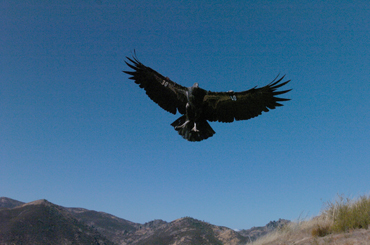
First one found near Monument in 70 years
Biologists at Pinnacles National Monument this week announced
the discovery of the first California condor nest in San Benito
County since they began recovery efforts in 2003. The nest is
believed to be the first in the wild near Pinnacles National
Monument in 70 years.
First one found near Monument in 70 years
Biologists at Pinnacles National Monument this week announced the discovery of the first California condor nest in San Benito County since they began recovery efforts in 2003. The nest is believed to be the first in the wild near Pinnacles National Monument in 70 years.
“We were ecstatic,” said Carl Brenner, chief of interpretation and education for Pinnacles National Monument. “It was a wonderful find. It’s something we’ve been hoping for for a long time – waiting for the day to arrive when we could finally see some of the birds nest.”
Male condor 313 has paired with female condor 303. Bird 313 was released from the Monument in 2004 at 1-1/2 years old. The female bird is now 6 and was released along the Big Sur coast by the Ventana Wildlife Society.
“They do pair for life, and this is about as young as they get,” Brenner said. “This is their first attempt – they are just maturing into that age.
Birds generally do not nest until they are at least 6 years old, and then they lay one egg every two years.
Biologists track the birds using radio telemetry and global positioning technology, and realized that the two birds had been regularly alternating visits to the remote cliff, a sign that the birds were trading off incubation duties.
“We were hopeful because they were starting to show signs that they were going to have a nest,” Brenner said. “Staying close together, moving in and out of areas alternately, but until we could work with the ranch owners to look at the nest, we weren’t really certain.”
The location of the nest, which is on a private ranch outside of the monument, has not been disclosed. Staff are working with the ranchers to create a nest monitoring strategy, and the property owners will maintain ranch operations.
“This has been a rewarding opportunity to work with our community toward common goals,” said Daniel George, condor program manager at Pinnacles, in a press release. “Both the ranchers and the condors will benefit from a continuation of successful ranching operations.”
According to a press release from Pinnacles National Monument staff, biologists will closely monitor the nest to see if the new parents succeed in incubating the egg and rearing a young bird to fledge from the high rocky cliff.
“They are not like other birds who build nests,” Brenner said. “They tend to find rock faces and cliff edges and they might move some items around, but they spend their time hunting for food as opposed to building nests.”
Condors nest in remote areas.
“If you sat down with a pencil and paper, you couldn’t draw a better nest site,” said Mark Paxton, a board member for the Pinnacles Partnership. “It is nine-feet deep on a vertical wall. The birds are young, but they seem to get parenting.”
Biologists saw the egg when condor 313 stood and turned it. Condor eggs take an average of 57 days to hatch, and the nestlings cannot fly for up to six months. Biologists estimate that the bird will be ready to take its first flight in October, if the parents are successful in rearing it. The birds care for their young through the next breeding season.
“This is like extremely excited parents watching their children,” Brenner said. “That is what our biologists are like.”
Pinnacles National Monument staff work with a variety of agencies to maintain the Condor Recovery project, including zoos, other release facilities, U.S. Fish and Wildlife, and private property owners near the monument.
Condors come to Pinnacles National Monument at the age of 1 year from breeding programs established at the San Diego Wild Animal Park, Los Angeles Zoo, the World Center for Birds of Prey in Boise, Idaho, and the Oregon Zoo. At the zoos, some eggs are raised by adult birds while others are taken from the birds and raised by humans using puppets, to prompt the birds to lay eggs more frequently than one every two years.
“By understanding how they breed and rear their chicks, we were able to move from one chick every two years to four every two years,” Brenner said. “This will be our first egg and we’ve not been involved in the process before that.”
Pinnacles biologists have released five groups of condors, and the flock now includes 23 birds living in the wild. The number of condors in the wild dwindled to 22 in the 1980s, according to Brenner. The birds had been threatened by lead poisoning, egg collecting, DDT and habitat degradation since the mid 1880s. Now there are 322 free-flying birds in California, Arizona and Mexico.
“We will be very excited when the other birds decide they are going to nest,” Brenner said.
Melissa Flores can be reached at mf*****@**********ws.com.









